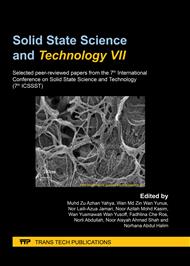[1]
A. Mandelis, Focus on materials, semiconductors, vacuum, and cryogenics, Journal Physics Today 72(10) (2019) 68-69.
DOI: 10.1063/pt.3.4324
Google Scholar
[2]
X. Wang, Flexible Transparent Thin Film Electrodes, Conference: Printed and Flexible Electronics Congress 2017 in London, United Kingdom, (2017).
Google Scholar
[3]
A. B. Kashyout, M. Fathy, S. Gad, Y. Badr, A. A. Bishara, Synthesis of Nanostructure InxGa1-xN Bulk Alloys and Thin Films for LED Devices, Photonics 6(2) (2019) 44.
DOI: 10.3390/photonics6020044
Google Scholar
[4]
S. H. Chen, Thin Film Solar Cells, Optical Interference Coatings 2016.
Google Scholar
[5]
M. Kimura, Thin film transistors for active-matrix LCDs, in: s. Ishihara, S. Kobayashi, Y. Ukai, High-Quality Liquid Crystal Displays and Smart Devices - Volume 1: Development, display applications, and components, Institution of Engineering and Technology, 2019, pp.255-270.
DOI: 10.1049/pbcs068f_ch14
Google Scholar
[6]
C. L. Lu, S-J. Chang, T. C. Weng, T. J. Hsueh, A Bifacial SnO2 Thin Film Ethanol Gas Sensor, IEEE Electron Device Letters PP(99) (2018) 1-1.
DOI: 10.1109/led.2018.2846807
Google Scholar
[7]
A. S. Pawbake, R. G. Waykar, D. J. Late, S. R. Jadkar, Highly Transparent Wafer-Scale Synthesis of Crystalline WS2 Nanoparticle Thin Film for Photodetector and Humidity-Sensing Applications, ACS Applied Materials & Interfaces 8(5) (2016) 3359–3365.
DOI: 10.1021/acsami.5b11325
Google Scholar
[8]
M. R. Panigrahi, M. Devi, Variation of Optical and Electrical Properties of Zr Doped TiO2 Thin Films with Different Annealing Temperatures, Journal of Physics: Conference Series 1172 (2019) 012046.
DOI: 10.1088/1742-6596/1172/1/012046
Google Scholar
[9]
M. A. Yıldırım, S. T. Yıldırım, E. F. Sakar, A. Ateş, Synthesis, characterization and dielectric properties of SnO2 thin films. Spectrochimica Acta Part A: Molecular and Biomolecular Spectroscopy 133 (2014) 60–65.
DOI: 10.1016/j.saa.2014.05.035
Google Scholar
[10]
A. Arif, O. Belahssen, S. Gareh, S. Benramache, The calculation of bandgap energy in zinc oxide films. Journal of Semiconductors 36(1) (2015) 013001.
DOI: 10.1088/1674-4926/36/1/013001
Google Scholar
[11]
D. L. Kamble, N. S. Harale, V. L. Patil, P. S. Patil, L. D. Kadam, Characterization and NO2 gas sensing properties of spray pyrolyzed SnO2 thin films, Journal of Analytical and Applied Pyrolysis 127 (2017) 38–46.
DOI: 10.1016/j.jaap.2017.09.004
Google Scholar
[12]
A. Doyan, Susilawati, N. Ikraman, M. Taufik, Characterization of SnO2 Film with Al-Zn Doping Using Sol-Gel Dip Coating Techniques. Journal of Physics: Conference Series 1011 (2018) 012015.
DOI: 10.1088/1742-6596/1011/1/012015
Google Scholar
[13]
E. López, J. Marín, J. Osorio, Synthesis, and characterization of SnO2 thin films doped with Fe to 10%, aip Conference Proceedings 1598(1) (2014) 51-54.
DOI: 10.1063/1.4878277
Google Scholar
[14]
L. Muliyadi, A. Doyan, Susilawati, S. Hakim, Synthesis of SnO2 Thin Layer with a Doping Fluorine by Sol-Gel Spin Coating Method, Journal of Research in Science Education 5(2) (2019) 175-178.
DOI: 10.29303/jppipa.v5i2.257
Google Scholar
[15]
S. Hakim, A. Doyan, Susilawati, L. Muliyadi, Synthesis Thin Films SnO2 with Doping Indium by Sol-gel Spin coating, Journal of Research in Science Education 5(2) (2019) 171-174.
DOI: 10.29303/jppipa.v5i2.254
Google Scholar
[16]
K. Kaviyarasu, C. M. Magdalane, K. Kanimozhi, J. Kennedy, B. Siddhardha, E. S. Reddy, M. Maaza, Elucidation of photocatalysis, photoluminescence and antibacterial studies of ZnO thin films by spin coating method, Journal of Photochemistry and Photobiology B: Biology 173 (2017) 466–475.
DOI: 10.1016/j.jphotobiol.2017.06.026
Google Scholar
[17]
Susilawati, A. Doyan, L. Muliyadi, S. Hakim, Growth of Tin Oxide Thin Film by Aluminum and Fluorine Doping Using Spin Coating Sol-Gel Techniques, Journal of Research in Science Education 6 (1) (2019) 1-4.
DOI: 10.29303/jppipa.v6i1.264
Google Scholar
[18]
M. S. Bannur, A. Antony, K. I. Maddani, P. Poornesh, A. Rao, K. S. Choudhari, Tailoring the nonlinear optical susceptibility χ(3), photoluminescence and optical band gap of nanostructured SnO2 thin films by Zn doping for photonic device applications, Physica E: Low-Dimensional Systems and Nanostructures 103 (2018) 348–353.
DOI: 10.1016/j.physe.2018.06.025
Google Scholar
[19]
G. Bhatia, V. K. Gupta, M. M. Patidar, S. B. Srivasatava, D. Singh, M. Gangrade, V. Ganesan, Structural, morphological and electrical properties of Sb doped SnO2 thin film by spray pyrolysis, AIP Conference Proceedings 1953 (2018) 100084.
DOI: 10.1063/1.5033020
Google Scholar
[20]
Susilawati, A. Doyan, Dose-response and optical Properties of Dyed Poly Vinyl Alcohol-Trichloroacetic Acid Polymeric Blends Irradiated with Gamma-Rays, American Journal of Applied Science 6 (12) (2009) 2071-2077.
DOI: 10.3844/ajassp.2009.2071.2077
Google Scholar
[21]
R. Wielgosz, B. Kulyk, B. Turko, T. Chtouki, V. Kapustianyk, B. Sahraoui, Nanostructured CuO Thin Film for Nonlinear Optical Applications, 2019 21st International Conference on Transparent Optical Networks (ICTON) (2019) 1-4.
DOI: 10.1109/icton.2019.8840496
Google Scholar
[22]
A. Doyan, Susilawati, Y. D. Imawanti, Synthesis and Characterization of SnO2 thin layer with a doping Aluminum is deposited on Quartz Substrates, American Institute of Physics 1801 (2017) 1-7.
DOI: 10.1063/1.4973083
Google Scholar
[23]
A. Doyan, Susilawati, Y. D. Imawanti, E. R. Gunawan, M. Taufik, Characterization Thin Film Nano Particle Of Aluminum Tin Oxide (AITO) as Touch Screen, Journal of Physics 1097 (2017) 1-9.
DOI: 10.1088/1742-6596/1097/1/012009
Google Scholar
[24]
A. Doyan, Susilawati, S. A. Fitri, S. Ahzan, Cristal Structure Characterization of Thin Layer Zinc Oxide, Materials Science and Engineering 196 (2017) 1-6.
DOI: 10.1088/1757-899x/196/1/012004
Google Scholar
[25]
A. Doyan, Susilawati, A. Harjono, S. Azzahra, M. Taufik, Characterization of Tin Oxide Doping Antimony Thin Layer With Sol-Gel Spin Coating Method for Electronic Device, Journal Materials Science Forum 966 (2019) 30-34.
DOI: 10.4028/www.scientific.net/msf.966.30
Google Scholar


